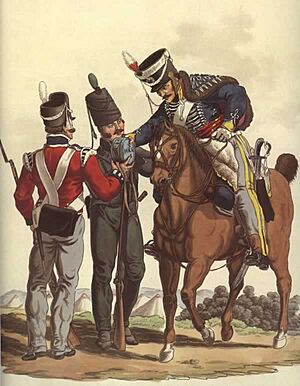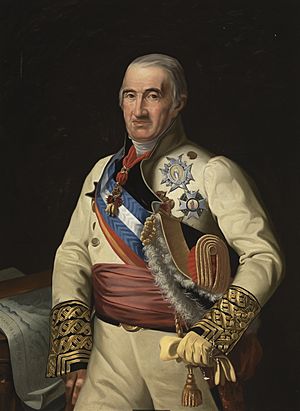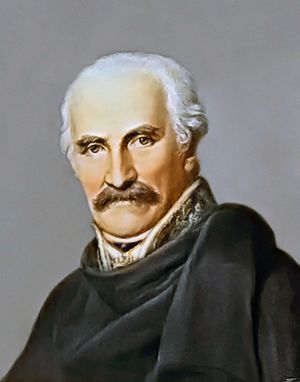Coalition forces of the Napoleonic Wars facts for kids
The Coalition forces of the Napoleonic Wars were the armies that fought against Napoleon Bonaparte and his French Empire. These forces included many powerful countries like the United Kingdom, the Austrian Empire, Kingdom of Prussia, Spain, Russia, and others. They also included the Ottoman Empire, Portugal, Kingdom of Sweden, and various German and Italian states at different times.
At their strongest, the Coalition had about 1,740,000 soldiers. This was more than the 1.1 million French soldiers. The biggest armies were from Austria (570,000), Britain (250,000), Prussia (300,000), and Russia (600,000).

British Forces in the Napoleonic Wars
The British Army had about 250,000 soldiers at its peak. This was amazing because it was 2% of Britain's whole population! Important parts of the British army included the King's German Legion (18,000 men), Brunswick troops, and soldiers from France, Switzerland, and the Netherlands.
While Britain fought many battles on land, the Royal Navy was super strong at sea. It helped destroy the French navy in big sea battles. The most famous was the Battle of Trafalgar in 1805.
British Infantry: The Redcoats
The British foot soldiers, often called the redcoats because of their bright red uniforms, became a very strong force. They learned a lot under the Duke of Wellington during the Peninsular War. They used tactics like disciplined group firing and bayonet charges, which brought them much success.
These soldiers usually carried the 'Brown Bess' musket. This gun wasn't very accurate on its own. But the British made up for it by having many soldiers fire together in groups.
Light Infantry and Their Rifles
British and German elite light infantry had a special advantage. They used Baker rifles. These rifles had grooved barrels, which made them very accurate over long distances. This was better than the muskets the French soldiers used.
Napoleon chose muskets for his soldiers because they could load faster. But this choice had big effects on the battlefield. British and German light battalions often fought in pairs. They spread out, used cover, and fought independently. These were new tactics that some older officers didn't like. But they were very good at targeting enemy officers.
Line Infantry Formations

During the Napoleonic era, soldiers used three main formations: the line, column, and square. Each formation had a different purpose for attacking or defending.
The line formation was a favorite for British infantry. When lined up, all soldiers could fire at once. This created huge firepower, shooting about 1000 to 1500 bullets per minute. The French often used the column formation. But only the soldiers in the first row (about 60 men) could fire at once.
While the line formation was great against other infantry, it was weak against cavalry attacks. If enemy cavalry attacked from the back or with force, it could cause chaos and many casualties. So, if cavalry appeared, battalions quickly changed to a square formation. This protected their backs against the faster cavalry.
The square formation was usually the best defense against cavalry. Horses were very unwilling to run into a wall of bayonets that were three or more lines deep. Only a few times were square formations broken by cavalry. One example was at the Battle of Salamanca, where three French squares were broken by the King's German Legion's heavy dragoons.
Bayonets were used to finish fights or in close skirmishes. People at the time said that when two regiments charged with bayonets, they "never" actually fought hand-to-hand. Instead, one side would run away as soon as the other got close enough to cause harm. It seems the fear of the bayonet was often more important than the bayonet itself. However, bayonets were used a lot in battles like the Battle of Fuentes de Oñoro.
British Cavalry: Mounted Soldiers
Britain often had too few cavalry soldiers. Poor leadership and a lack of discipline sometimes wasted good chances and lives. British cavalry developed some key tactics. Against infantry, they would charge right after the enemy infantry fired their guns. This meant fewer muskets could shoot back at the cavalry because the infantry would be busy reloading. The infantry square formation was the best way to outsmart cavalry.
- Household Regiments – These were a type of heavy cavalry. The Life Guards and the Royal Horse Guards weren't very useful early in the wars. But they were heroes at the Battle of Waterloo.
- Heavy Dragoons – These were also heavy cavalry. They included Dragoon Guards and Dragoons. These were large men on large horses, used as shock troops. They would charge into battle to help a weak line or break through enemy formations. Dragoons sometimes fought on foot using carbines, which were shorter muskets.
- Light Dragoons – These soldiers were good at patrolling, scouting, and screening. The best British units were from the King's German Legion. They did excellent work in the Peninsular War, especially with the light division. They even made history by breaking French Infantry squares at Garcia Hernandez.
- Hussars – Hussars were added to the British army after 1806. Four Light Dragoon regiments and three King's German Legion hussar regiments became hussars.
British Artillery: Cannons and Rockets
Britain had a small but very effective artillery force called the Royal Artillery. They were well trained but only had light guns. British cannon barrels were made of brass. The carriages and wheels were painted grey, and metal parts were black.
The main guns were three to six pounders. The British were at a disadvantage against the stronger French cannons. The Duke of Wellington even told his gunners not to shoot back at French cannons. Instead, he ordered them to focus on firing at enemy troops. Artillery was divided into horse artillery and foot artillery. Each cannon had five gunners.
British artillery became even better at fighting enemy soldiers with a new invention. General Sir Henry Shrapnel designed a special shell that exploded above enemy troops. It then showered them with musket balls.
Cannon Ranges
| Gun Type (caliber) | Maximum (metres) | Effective (metres) | Firing Canister |
|---|---|---|---|
| 3-pounder | 1000 | 320–400 | approx. 275 |
| 6-pounder | 1100–1350 | 550–640 | 320–360 |
| 9-pounder | 1550 | 725–825 | 410 |
Howitzer Ranges
| Gun Type (caliber) | Maximum (metres) | Effective (metres) | Firing Canister |
|---|---|---|---|
| 5.5-inch | 1550 | 640 | 460 |
Congreve Rockets
Another British invention was the Congreve rocket. These rockets were meant to fire a barrage of 12-pounder explosives towards the enemy.
However, the rockets were not very accurate. They were used in Spain and Portugal and in Germany during the Battle of Leipzig. But they weren't seen as very effective. Mostly, they scared enemy troops who had never seen such a weapon before. The French first thought the rocket troops were "lancers" because the firing device looked like a lance from far away.
British Commanders
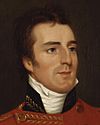 |
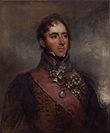 |
| Duke of Wellington | Sir Henry Paget |
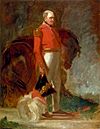 |
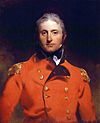 |
| Sir Rowland Hill | Sir John Moore |
- Arthur Wellesley, 1st Duke of Wellington
- Robert Craufurd
- Thomas Graham, 1st Baron Lynedoch
- Henry Paget, 1st Marquess of Anglesey
- Rowland Hill, 1st Viscount Hill
- Sir Isaac Brock
- Stapleton Cotton, 1st Viscount Combermere
- Sir Thomas Picton
- Sir John Moore
- William I of the Netherlands (as Dutch Commander)
- Sir Edward Pakenham
- John Le Marchant
- Colin Halkett
- Charles Alten
Allied Forces: Learning New Tactics
At the start of the wars, the tactics of the other allied forces were different from the British. For example, they tried to use the column formation. But since they almost always lost against the French, they had to change their system. Their approach became more and more like the British systems. However, there were still some differences. For instance, the Prussian line formation was three men deep, while the British line was two men deep.
Austrian Empire
Key Austrian commanders included:
- Karl Philipp, Prince of Schwarzenberg
- Archduke Charles, Duke of Teschen
- Karl Mack von Leiberich
- Archduke John of Austria
Kingdom of Portugal
The army of Portugal needed a lot of updating. Many British officers joined the Portuguese army to help. They trained the army to be like the British army. This created a force with great fighting spirit and skills. The caçadores (Portuguese light infantry) were as good as the British light infantry. They fought side by side with their allies. Portuguese units were attached to British regiments. The Duke of Wellington was the commander of these combined forces.
Key Portuguese commanders included:
- William Beresford
- Francisco de Paula Leite
- Bernardim Freire de Andrade
- Miguel Pereira Forjaz
- Carlos Frederico Lecor
- Francisco Silveira
Kingdom of Prussia
Key Prussian commanders included:
- Gebhard Leberecht von Blücher
- Charles William Ferdinand, Duke of Brunswick
- Frederick Louis, Prince of Hohenlohe-Ingelfingen
Russian Empire
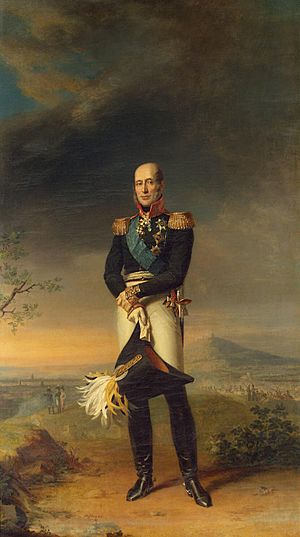
Key Russian commanders included:
- Michael Andreas Barclay de Tolly
- Mikhail Illarionovich Kutuzov
- Count Bennigsen
- Pyotr Bagration
- Peter Wittgenstein
Kingdom of Spain
After Spain was defeated and its king was sent to France, the Spanish army was split into several parts between 1812 and 1814.
- The 1st army in Catalonia was broken up by the French in 1811. But it reformed and by 1813 had 16,000 men under General Francisco Copons y Navia.
- The 2nd army in Valencia was defeated. But it reformed in 1813 under General Elio and had 30,000 men. It included former guerrilla troops.
- The 3rd army in Murcia had 21,000 men in 1814 under the Prince of Anglona.
- The 4th army, with between 30,000 and 46,000 men, was under the command of the Duke of Wellington.
- The 5th to 9th armies were combined into the 4th army.
In 1813, the Spanish troops had about 160,000 men. The Spanish guerrilla troops were also very active. In 1812, they were the strongest Spanish forces. They often fought independently but were also coordinated by the British. There was a guerrilla force on the British right side during the Battle of Fuentes de Onoro.
Key Spanish commanders included:
Kingdom of Sweden
|


